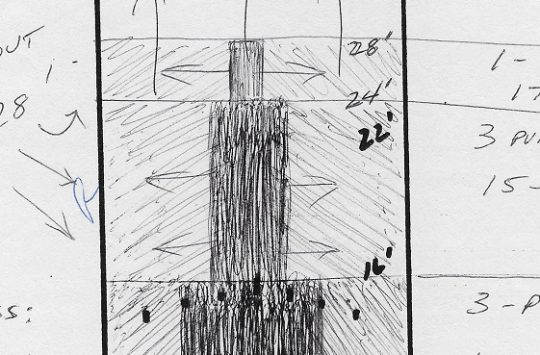Chicago-Area Teams Sweep 50th Hoosier Classic Featuring 'Antique' Lane Pattern

BY DENNIS BERGENDORF AND GIANMARC MANZIONE
National collegiate bowling powerhouse Robert Morris University took top honors in the men’s division of the Columbia 300 Hoosier Classic, while an underdog University of St. Francis team surprised a stellar field on the women’s side.
The Chicago-based Robert Morris led 21 games of qualifying, then won two matches in the round of eight to set up the championship contest with Wisconsin-Whitewater. Robert Morris won, three games to two.
St. Francis, also from the Chicago area, nearly missed the round of eight, having qualified in a tie for sixth, but had little trouble with its first two matches. In the finale, the Fighting Saints beat perennial favorite Webber International three games to one.
The classic was held at Indianapolis’s 80-lane Western Bowl, and attracted 144 collegiate teams. It was the final tier-1 event of the 2018-2019 United States Bowling Congress Collegiate season. Some teams see the Hoosier Classic as a final tune-up for IBC sectional competition, set for early March.
USBC's BowlTV captured legendary lane man Len Nicholson conditioning the lanes the old-fashioned way... with a spray gun.
Lanes in the round of eight were conditioned partly by hand by PBA Hall of Fame lane technician Len Nicholson, who used a vintage spray gun to lay down the “Christmas tree” pattern. Bowlers found the condition particularly challenging.
Nicholson followed guidelines dating back nearly three decades as crude drawings and hand-written notes from the 1991 US Open at Woodland Bowl served as a “template” for the pattern.
While qualifying was conducted on patterns laid down by sophisticated Kegel Flex lane machines, which can apply microliters of conditioner at any of thousands of points on the surface, allowing the lane man to control various aspects of players’ ball reaction, Nicholson used a hand-held spray gun, walking from the foul line down to a point some 15 feet from the headpin. The conditioner volume and placement were controlled by how high he held the sprayer from the lane surface, how fast he walked, and where he pointed it, left-to-right.
It’s a true art form, something Nicholson perfected during years as the PBA Tour’s lane maintenance director, when he created patterns to challenge the world’s best bowlers. Though retired from the PBA, the man known as The Phantom has been active in promoting the sport, including working for Kegel as a consultant while hosting the long-running podcast, “Phantom Radio.”
"It was thrilling," Nicholson told BJI. "I'd never had so many people who had never heard of me, which was great, and had never heard of a spray gun, which also was great. Some people were saying, 'I've never seen anything like this. It's going to be impossible!' And I told them we used the spray gun when Bob Learn averaged 282 on TV . What do you mean, they're going to be impossible?'
 Crude drawings and hand-written notes from the 1991 US Open at Woodland Bowl served as a “template” for the pattern used in the later stages of the Hoosier Classic.
Crude drawings and hand-written notes from the 1991 US Open at Woodland Bowl served as a “template” for the pattern used in the later stages of the Hoosier Classic.
"Nick Hoagland loves challenge and he wanted to challenge the kids, especially on the 50th anniversary of this big tournament," Nicholson added. "He wanted something from the old days. We found the pre-tournament check paperwork from the 1991 U.S. Open, but that was at a different bowling center with a different lane finish on wood at a time back in the day with different oils and no resin balls, so right away I said, 'That's not gonna be enough oil.'
"We added to that, and then we had a practice session with Steve Jaros and Matt McNiel and a couple other local guys, and they hooked immensely. We did another pair with more oil and they still hooked. So we put more oil, and then they became okay at the fourth arrow but if you missed right, they flew. We did one more pair, and they were okay. I knew it was going to be a challenge, but these kids, they like a challenge nowadays.
"The first ball they threw, they didn't know anything, they started out with resin and the righties picked off the 7-pin and the lefties picked off the 10-pin, and there was a mad rush back to the bowling balls that they had in the back of the concourse. They ran back for urethane, and then they ran back for plastic. They were tough but I've never seen so many smiles and I've never seen more competition where spares now were so important, and high fives when guys were making 10-pins.
"I talked to a lot of coaches who said this is the way it should be. These kids today want a challenge. Well, that's what they got! They couldn't go to their favorite ball and find any hold."
In the 21st century, lane patterns are displayed as precise multi-colored graphs. But 1991’s “graph” is hand-drawn, with oil concentrations literally scribbled in. The drawing resembles a very tall wedding cake, and indicates a pattern that tapers inward as it gets closer to the pins (which reduces players’ margin of error).
In addition to scholarships, the weekend raised funds for Make-A-Wish, which will send a five-year-old central Indiana girl with leukemia to Disney World with her family.





